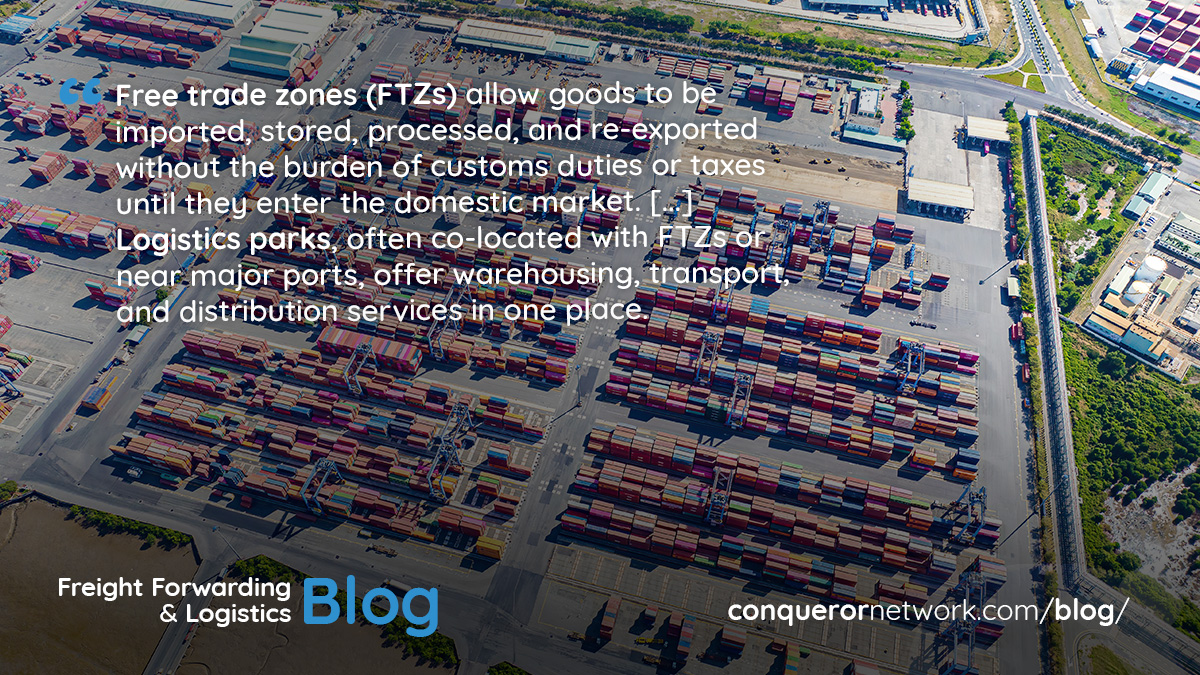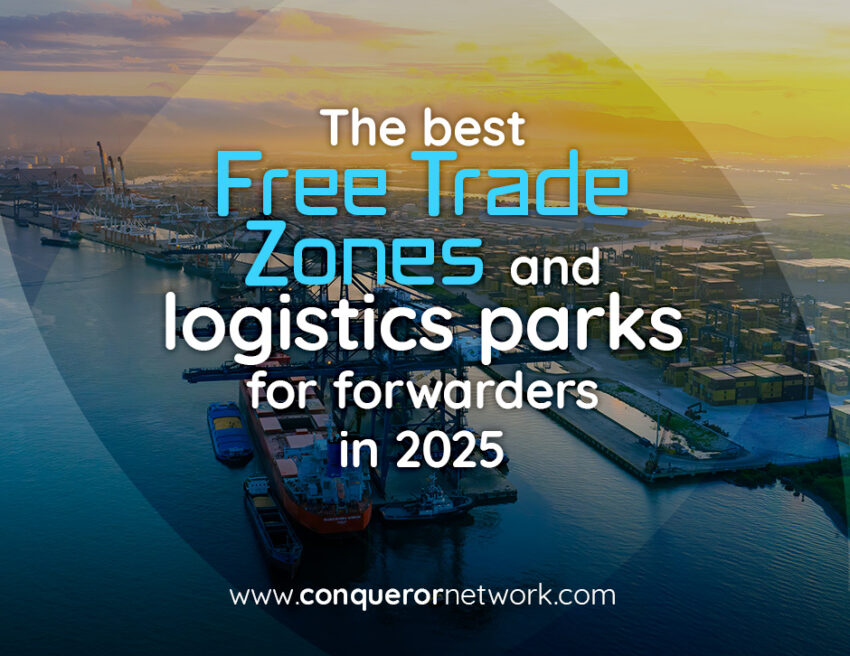For freight forwarders looking to stay competitive in 2025, choosing the right base of operations goes far beyond location. It’s about agility, access, and cost-efficiency. Free trade zones and logistics parks offer all three plus incentives that can give forwarders a serious edge. These zones are designed to eliminate friction, reduce overhead, and accelerate cargo movement. In short, they are where global trade meets logistics innovation.
As trade patterns shift and supply chains diversify, forwarders are rethinking their strategic positioning. Whether it’s to bypass bottlenecks, lower costs, or get closer to manufacturing clusters, setting up within a well-planned logistics park or free trade zone can deliver immediate and long-term advantages.
So let’s dive into some of the best free trade zones and logistics parks for forwarders in 2025 and understand why they matter.

Why free trade zones and logistics parks matter
Free trade zones (FTZs) allow goods to be imported, stored, processed, and re-exported without the burden of customs duties or taxes until they enter the domestic market. That means goods can be repackaged, assembled, or stored indefinitely with minimal red tape. Logistics parks, often co-located with FTZs or near major ports, offer warehousing, transport, and distribution services in one place. This translates to faster handling, lower transit costs, and seamless multimodal connections.
For freight forwarders, this setup simplifies coordination and improves turnaround. Whether you’re dealing with time-sensitive shipments or complex multi-country routes, being inside a logistics park or FTZ brings predictability and efficiency.
Jebel Ali Free Zone (Jafza), UAE: The benchmark
Jebel Ali Free Zone in Dubai is a logistics legend. Adjacent to Jebel Ali Port and with direct access to Al Maktoum International Airport, JAFZA remains one of the most powerful logistics hubs in the Middle East. It hosts more than 8,700 companies and handles roughly a quarter of Dubai’s total non-oil exports.
Forwarders benefit from no corporate taxes, full foreign ownership, and a vast network of service providers. In 2025, JAFZA continues to expand its role in linking Asia, Europe, and Africa, making it one of the best free trade zones for logistics.
Klang Valley Logistics Corridor, Malaysia: Southeast Asia’s rising star
Malaysia has been making strategic investments in logistics infrastructure, and the Klang Valley Logistics Corridor stands out. Anchored by Port Klang and supported by nearby free zones and industrial parks, it’s becoming a serious alternative to Singapore for forwarders.
The Westports and Northport terminals offer high capacity and low congestion. The integrated free commercial zone allows for cargo consolidation, value-added services, and re-export, all under one umbrella. The nearby logistics parks tie in road, rail, and airport access for total multimodal efficiency.
Cai Mep Logistics Center, Vietnam: Expanding reach into global markets
Vietnam’s booming manufacturing sector is driving the rapid development of logistics parks and FTZs. The Cai Mep Logistics Center, near the deepwater Cai Mep-Thi Vai Port, is designed to support export-driven growth. It connects to industrial zones across southern Vietnam and offers direct shipping routes to Europe and North America.
Forwarders operating here get access to customs incentives, modern warehousing, and dedicated infrastructure for containerized cargo. It’s especially attractive for handling electronics, garments, and other high-volume goods moving in and out of ASEAN markets.
Zhejiang Free Trade Zone, China: Focused on energy and smart logistics
Unlike older trade zones built purely for scale, Zhejiang FTZ is designed around specialization. It has become a key hub for petrochemical imports, smart warehousing, and blockchain-enabled customs systems. Its port Zhoushan is a gateway for maritime trade along the Yangtze River Delta, one of China’s biggest export engines.
The logistics parks inside the zone cater to both bulk and containerized cargo. With digital trade facilitation tools and integration with China’s Belt and Road projects, Zhejiang is one of the most future-ready free trade zones for forwarders to tap into.
Panama Pacifico, Panama: Bridging the Americas
Panama Pacifico combines a special economic zone, an international business park, and logistics infrastructure—all a few kilometers from the Panama Canal. This setup makes it a perfect base for companies handling trade between North and South America, or Asia to the Atlantic coast of the US.
Panama Pacifico offers tax exemptions, streamlined import/export regulations, and multimodal access to ports and Tocumen International Airport. The zone is ideal for forwarders managing Latin American distribution and transshipment.
Dachser Logistics Park, Germany: precision in Europe’s industrial heartland
In Germany, logistics parks tend to prioritize precision and planning. The Dachser Logistics Park in Kempten serves as a model of operational excellence, especially for overland European freight. The park includes temperature-controlled warehouses, automated sorting systems, and seamless integration with Dachser’s road and rail network.
While not a free trade zone in the strict sense, it offers the operational advantages that freight forwarders seek: control, consistency, and visibility across borders. It’s especially useful for handling high-value goods and pharmaceuticals within the EU.
Tanger Med port and Logistics Platform, Morocco: Africa’s key logistics hub
Tanger Med has transformed Morocco into a critical node between Europe, West Africa, and the Americas. With one of the largest port capacities in Africa, it is backed by a vast logistics zone offering duty exemptions and simplified customs.
Its industrial free zones host major multinationals from the automotive, textiles, and electronics sectors. For forwarders, Tanger Med offers access to growing African markets and a low-cost alternative to European ports. And with direct ferry links to Spain and beyond, it’s ideal for ro-ro and container logistics.
Freeport zone, Philippines: Pacific gateway for forwarders
Subic Bay Freeport Zone is reemerging as a key logistics destination in the Asia-Pacific. With modern container terminals, tax incentives, and proximity to Manila, it’s attracting forwarders looking to avoid congestion in the capital.
The zone is linked to industrial parks and highways leading north into Luzon’s manufacturing belt. It’s particularly useful for e-commerce fulfillment, temperature-sensitive cargo, and distribution across Southeast Asia.
How to choose the right zone or logistics park
Not all free trade zones or logistics parks are created equal. Forwarders should evaluate zones based on:
-
Proximity to key ports or airports: Quick access reduces drayage time and costs
-
Incentive packages: Customs benefits, tax exemptions, and regulatory flexibility can offer a major boost
-
Multimodal infrastructure: The best zones integrate road, rail, sea, and air seamlessly
-
Technology and digitalization: Smart customs processes and inventory systems mean smoother operations
-
Tenant ecosystem: Zones that host shippers, carriers, 3PLs, and manufacturers offer collaboration opportunities
Final thoughts: Logistics positioning in 2025
The best free trade zones for logistics and the top logistics parks of 2025 are not just real estate. They are strategic tools. For forwarders navigating a fast-changing global trade environment, being inside the right logistics hub can mean faster customs clearance, smoother handoffs, and stronger margins.
These zones are evolving rapidly. Governments are investing. Supply chains are adapting. And forwarders who place themselves at the heart of this evolution will have a distinct edge access to new markets, better partners, and fewer delays.
As trade becomes more regionalized and clients expect precision and speed, positioning your business inside one of these high-performance zones may be one of the smartest moves you make this year.


